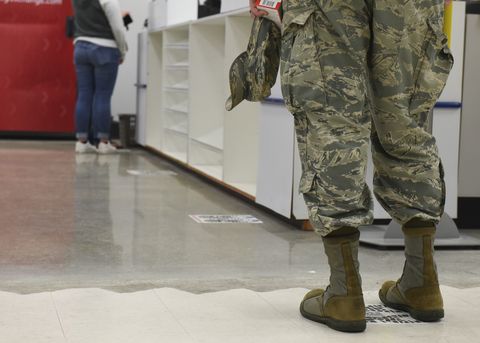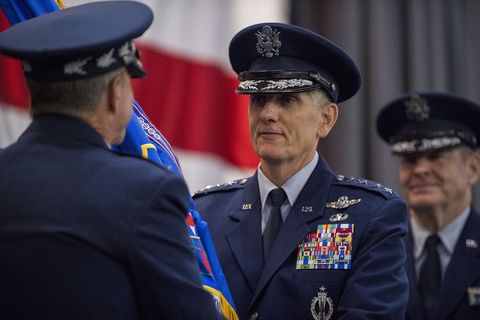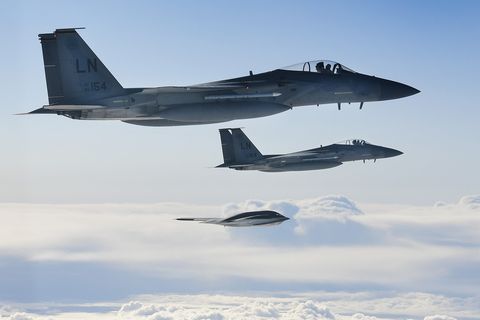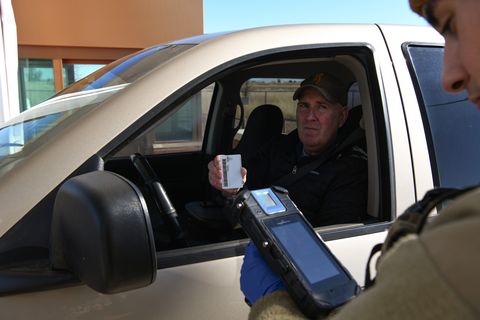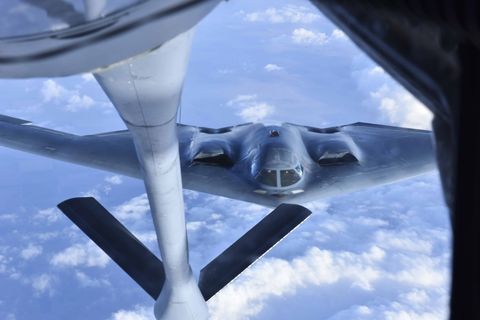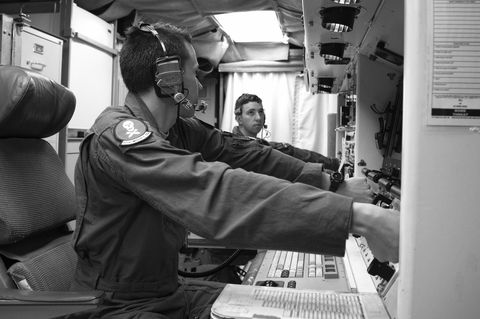Relying on a high-state of readiness, the nuclear triad is under threat from the coronavirus. But the head of Global Strike Command tells Popular Mechanics that its nukes are still ready to fly.
As the world fights against the COVID-19 pandemic, nuclear weapons have taken a backseat in most people’s minds. But for Global Strike Command (AFGSC)—the Air Force unit in control of two of the three legs of America’s nuclear triad—their mission remains top priority.
And it’s an unforgiving business. Nuclear deterrence requires extreme levels of readiness among pilots, maintenance crews, and security teams. Adversaries that don’t think the U.S. can respond with conventional bombing strikes or nukes could be emboldened to act aggressively.
But in a War of the Worlds-style twist, humanity’s most lethal weapons could be nullified by an organism that can’t even be seen. It’s up to the AFGSC to make sure that never happens.
Surviving at a Distance
Air Force officials tell Popular Mechanics that ICBM crews are rotating to specifically ensure there is always a “clean team” that can take over if others report sick. Members of the bomber community could find themselves in similar protective isolation. “As COVID-19 continues to spread, we carefully assess additional precautions, one of which is the isolation of crews and other personnel.” the USAF 8th Air Force said in a statement to Popular Mechanics.
“Our long-range strike capability from bombers, both conventional and nuclear, and our ICBMs have to continue to operate in the background and to do what’s needed, when it’s needed,” Gen. Timothy M. Ray Commander, Air Force Global Strike Command, tells Popular Mechanics. He calls America’s arsenal of nuclear bombs and missiles “the foundation of the security structure of the free world. We know that and we’ve got to make sure that it’s viable.”
The viral outbreak has put a new spin on the idea that nuclear weapons are safer because they’re scattered in rural areas. The original reason for these remote locations has been protecting missiles from first strike nuclear attacks. ICBM launch capsules, each operated by a two-person crew, are hardwired with fist-size communication lines that monitor 50 missiles in remote silos and are directly responsible for 10 missiles in nearby silos. With this layout, any one nuke can’t take out all America’s ICBMs.
“The dispersal of things makes it better. The ICBM fields in Montana are just vast,” Ray says. “We’re not all clustered in a small place and we’re not all collected in the one or two locations. We’re pretty spread out.”
The Air Force’s nuclear weapons are not parked on the coasts, where Russian and Chinese submarines can more easily reach them. Instead, they are in midwestern bases—most notably B-2 nuclear bombers in Whiteman Air Force Base in Missouri and ICBMs parked in North Dakota and Montana.
“The good news is we live in communities that are not high-risk. North Dakota is not the same as New York City. We’re taking advantage of that,” Ray says.
This relative isolation makes breaking the cycle of a possible infection much easier than what has being seen in crowded cities. “Once you’ve done a good job to isolate and protect yourself, it’s a little easier to keep them healthy,” Ray says.
Like many civilian jobs around the world, keeping airmen at a distance has inspired a boom in telework. But for the military, it’s a bit trickier than just logging onto Zoom. At Malmstrom Air Force Base in Montana, home of the 341st Missile Wing, personnel had to prepare for the influx of needed laptops.
Staff there say it can take up to six hours to properly prepare a new laptop for teleworking, including loading the latest Air Force Standard Desktop Configuration as well as the necessary cyber security patches. The team at Malmstrom devised a way to prepare 100 laptops in a single day, instead of the normal 600 hours.
Personnel at the Barksdale say they are relying on the secure-but-unclassified messaging services that were used ubiquitously in Afghanistan and Iraq to stay connected. This effort also extends to more sensitive parts of the launch command and control infrastructure.
“Never waste a good crisis, right? We’re looking at is a smarter way to do our communications,” Ray says. “Right now, we can start thinking about how we communicate with our classified stuff a whole lot more effectively.”
Breaking a Viral Siege
How badly the nuclear forces have been impacted by the pandemic will likely remain secret. Last week, U.S. Defense Secretary Mark Esper, in an interview with Reuters, said the military will reveal only broad data about infections in the armed forces. Esper wants “some of the more mission-specific information to be withheld to prevent compromising operational security. We’re not going to disaggregate numbers because it could reveal information about where we may be affected at a higher rate than maybe some other places.’”
Esper was referring to places where U.S. troops are engaged in combat operations, but USAF personnel say this logic extends to its most sensitive missions, including Global Strike readiness. However, Ray says his aircrews remain ready despite the health crisis.
“I’m not saying this is what we get paid to do, but we do get paid to do a mission under all kinds of conditions, to figure it out dynamically and to stay together as a team,” he said. “You’re seeing all those principles play out here in living color.”
Operations have been affected, but Ray says the missions are not hampered. The trick to doing this is differentiating the vital work from the things that can pushed to the margins during an emergency. If they can do this, GSC can sustain the same launch-on-command level of readiness.
“You have to keep your pace at a much more manageable level,” Ray says. “You’ll train a little less, but you can keep training; you can do maintenance, but you don’t have to do as much maintenance. You can fly sorties, but you don’t have to fly everything that you wanted to.”
Other branches have been impacted by the virus, but so far the military’s overall infection rate is better than the civilian numbers. The death rate across the Department of Defense and its contractors is also lower than the general public, at 0.2 percent. Only one active military member, a National Guard physician’s assistant, has died from coronavirus as of March 31.
“You’ve got your ability for someone to call ahead, drive up, and be assessed as the individual sits in their vehicle,” Ray says. “Then the guidance says, if this comes back as flu take this bag of medicine, if it comes back as COVID take this bag of medicine and take this bag for both because we’re treating symptoms. That way the individual doesn’t have to come back into the pharmacy.”
Small Teams, Big Impact
But small outbreaks can still impact operations. At least 38 Navy sailors on board the USS Theodore Roosevelt aircraft carrier in the western Pacific have tested positive for coronavirus so far. The conditions onboard a vessel is conducive to the spread of disease, as navies have long suffered through since the Age of Sail.
These kinds of isolated-but-intense flare-ups could hamper the Air Force’s bombers and ICBMs, especially if certain, specially-trained members take ill at the same time. Losing a small number of B-2 pilots, for example, would have a much greater impact than quarantining a dozen security team members.
Both B-2s and ICBM launch crews consist of two-person teams working in close quarters. This may seem like a recipe for infection. “If we know going in that they are both healthy, then that’s not a problem,” Ray says. “But if you want to put 40 or 50 people in a small room, you’re asking for trouble. Our missions don’t have to happen that way.”
But there is more to flying a bomber than just the air crew. Long-range bombers are not worthy of the name without a fleet of aerial refueling tankers that can top them off while in the air. These airplanes are controlled by Air Mobility Command, which has already taken a frontline role in the pandemic response.
Staff there say strict protocols, including passenger and crew screening prior to boarding, aims to prevent these aircrew and support personnel from contracting or transmitting the virus, especially if transiting global viral hot spots.
Dress Rehearsal for Disaster
Across the Air Force, personnel who typically do inspections for readiness exercises are now tasked to make sure that everyone has procedures for decontamination and screening people. These procedures were put to the test during a recent Virtual Table Top Exercise held by the 7th Bomb Wing and 317th Airlift Wing at Dyess AFB in Abilene, Texas.
The scenario was all too possible: an aircraft had just transported passengers which were later confirmed to have COVID-19. Air Force Global Strike Command base response providers, fire response, security, command post, emergency operations center, maintainers, Inspector General, and aircrew all participated.
The Air Force called the exercise “a valuable, realistic scenario, which tested the base ability to respond to a localized incident.” But in a sign of the times, the Air Force conducted the wargaming session with a slide presentation—shared remotely via web-based video conferencing.

